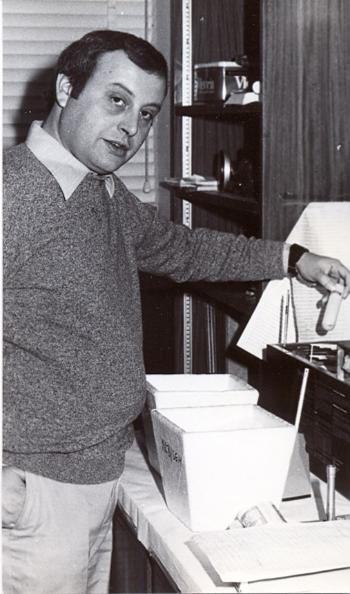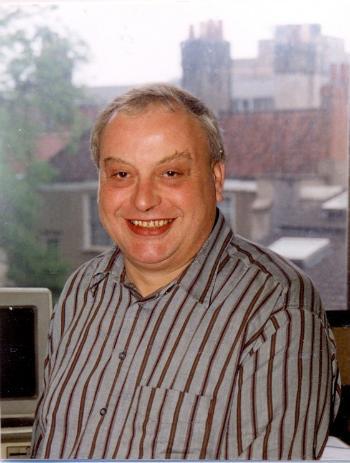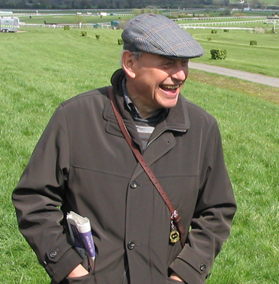Professor Stephen Halford FRS 1945 - 2022
Prof. Steve Halford FRS (affectionately “Halfs” to his friends) was a legendary Bristol biochemist for over 40 years, progressing from undergraduate to emeritus professor. Funded continuously by the Wellcome Trust and BBSRC, never having a research grant rejected, Steve was a leader in applying kinetic methods to DNA-protein interactions and in particular to the bacterial restriction endonucleases, enzymes that make double strand breaks at precise DNA sequences and helped drive the cloning revolution. His work revealed fundamental insights into how enzymes find specific sequences of bases amongst a myriad of non-specific sequences. Steve’s scientific achievements were recognised by the award of the Novartis Prize and Medal of the Biochemical Society in 2001 and by election as a fellow of the Royal Society in 2004. His legacy at Bristol is the strength of the DNA biochemistry that he helped to establish and nurture.
Stephen Edgar Halford was born 22nd September 1945 in Cairo, Egypt, the youngest of the three children of Jessie Edgar and Walter Halford. While at Rugby School, a period he didn’t particularly enjoy, he nonetheless developed a love of both chemistry and horse racing. The former led to him choosing to read Chemistry at Bristol in 1964. The latter almost led to him losing the shirt off his back when he bet his entire student grant on a single race at Cheltenham! Although the gamble paid off, Steve vowed to restrict his bets to smaller sums thereafter. After seeing an enthusiastic lecture by John Williams on how a small amino acid change in a protein can result in Sickle cell disease, Steve switched honours to Biochemistry, becoming part of only the second cohort of students in the new Department that had been established by Philip Randle in 1964. The “E6V mutation” would feature later in the title of a summer studentship that Steve endowed in 2011.
Following his B.Sc., Steve worked with Prof. Herbert “Freddie” Gutfreund FRS in the Molecular Enzymology Laboratory located in the Inner Court off Woodland Road, firstly as a PhD student (1967-70) and then, after a short sabbatical at Washington University in St. Louis, as a post-doc (1972-75), also collaborating with Sir Mark Richmond FRS of the Department of Microbiology and Brian Sykes of the Department of Chemistry, Harvard University. Freddie’s lab was famous for its work on enzyme kinetics and the development of rapid reaction methods, and it was here that Steve’s expertise in enzymology was forged. Steve said that when Freddie was “away being famous”, his true supervisor was a senior postdoc who later became a lecturer and FRS, David Trentham. Steve used relaxation spectroscopy to study the mechanisms of alkaline phosphatase, lysozyme and beta-lactamase. He said they chose enzymes that were easy to source and substrates that were off-the-shelf chemicals. Despite his modesty, Steve made important contributions to our understanding of how protein-ligand interactions drive protein conformational changes in a series of tour-de-force papers.
Following a brief stint as temporary lecturer, in 1976 Steve was made lecturer and occupied the Inner Court labs after Gutfreund moved to the Medical School, sharing the space with another new lecturer, Nigel Brown. Steve was looking for new proteins to study when Mark Richmond recommended that he consider the newly discovered restriction enzymes. At that time, there were only 12 available commercially in the UK (there are now hundreds) and Steve chose EcoRI. In the draft for his first grant in 1977, Steve led with the assertion, “There are only two problems in the biological sciences: DNA-protein interactions and the consequences thereof.” A proofread by Freddie put pay to this bold statement, but Steve’s ability to convince funders of the importance of restriction enzymes had begun.
Assisted by Nigel Brown and John Grinsted (Department of Microbiology), Steve produced DNA substrates necessary to measure EcoRI DNA cleavage activity. However, obtaining sufficient protein was more cumbersome; having grown 800 litres of Escherichia coli cells at the Applied Microbiology unit at Porton Down, the cell contents were pumped into a bathtub where a sackful of protein purification media was emptied and stirred with a paddle. The result was ~10 mL of EcoRI, sufficient to cut ~30 g of DNA and worth ~£1M; some of this enzyme remains to this day and is still active. However, the yield was only a few mg of protein, not really sufficient for “proper biochemistry”, so Steve switched to EcoRV, for which an overproducing strain was available from Marc Zabeau at EMBL. This choice began the next of Steve’s golden periods of research.

Steve at the lab bench, circa late 1970s
(uncredited)
Using EcoRV, Steve’s group were the first to measure accurately the exquisite specificity of restriction enzymes, demonstrating a million-fold faster cleavage at the target recognition site (5′-GATACT-3′) than the next best site (5′-GTTACT-3′). It was surprising therefore when Steve’s PhD student showed that EcoRV binds all DNA sequences with the same affinity, a result that Steve at first insisted could not be correct, so sending them back to the lab for multiple repeats. With the result confirmed, in a series of classic experiments Steve and his team demonstrated that EcoRV produced its specificity through catalysis rather than binding; association with the target site allowed the magnesium catalytic cofactor to bind with high affinity, a result confirmed later by Fritz Winkler’s crystal structure in 1993. This work led to Steve studying further the metal ion binding characteristics of EcoRV and proposing a 2-metal ion cleavage model, prompting a vigorous debate with Alfred Pingoud and John Perona who proposed alternative 1- and 3-metal ion models, respectively. EcoRV remains the best understood Type II restriction enzyme and Steve’s studies were a paradigm for other DNA-protein interactions.
A serendipitous choice in the 1990s then led to another golden period, one that Steve considered his best work. At the suggestion of Ira Schildkraut at New England Biolabs, Steve switched to SfiI. This enzyme looked like an attractive model system as its target site was longer, the protein was easily purified and was soluble, and structural data was forthcoming. Serendipity also played a role in the lab as the only DNA available with SfiI sites had two copies. This substrate was cleaved rapidly, with both sites cut in one binding event. A one-site DNA was eventually tested but it was cleaved slowly. In a series of breakthrough publications, he demonstrated that SfiI binds two sites simultaneously and therefore forms “DNA loops”. Steve’s insight was helped by having worked since the 1980s on a site-specific recombinase, Tn21 resolvase, that also interacts simultaneously with multiple DNA sequences. Further investigation of multiple restriction enzymes by Steve’s team using biochemical and single-molecule methods showed that the majority of restriction enzymes examined needed to interact with two sites to activate cleavage. It appeared that EcoRV was an unusual example of a simple dimeric enzyme binding one site.

Steve in his office, circa mid 1990s
(Photo credit): Simon Erskine
In the late 1990s, Steve was contacted by John Marko, a polymer physicist from the University of Illinois who was interested in how proteins find their target sites amongst many millions of alternative sites in a genome. Using EcoRV as a model system, they demonstrated that proteins use both 1- and 3-dimensional paths to locate target sequences, leading in 2004 to their classic treatise on “How do site‐specific DNA‐binding proteins find their targets?”. This work, now cited over 1000 times, argued for an optimal pathway of 1-dimensional motion over tens of base pairs interspersed with 3-dimensional “jumps” and “hops” over longer distances. Steve followed this with a series of elegant experiments on other restriction enzymes that re-enforced these ideas. Steve felt there had been too much woolly thinking in this area, making his thoughts clear in a 2009 paper, “An end to 40 years of mistakes in DNA-protein association kinetics?”, a reference to others’ misconceptions rather than his own.
Steve had many fruitful scientific collaborations. Discussions with Marshall Stark and Martin Boocock (University of Glasgow) on the resolvase mechanism produced a publication in Nature on how DNA supercoiling dictates reaction outcomes. This led to generations of Biochemistry undergrads being subjected by Steve, often wearing his famous “DNA jumper”, to the twists and turns of DNA topology illustrated using rubber tubing models. To follow DNA looping dynamics in more detail, Steve collaborated with Gijs Wuite (Vrije Universiteit Amsterdam) to use single-molecule force spectroscopy to directly observe the process using the FokI restriction enzyme. But the collaboration that Steve was most fond of was with Virginijus “Virgis” Šikšnys (Institute of Biotechnology, Lithuania). Steve met Virgis at a conference on restriction enzymes in Vilnius in the early 1990s, not long after the fall of communism. They remained in contact and obtained collaborative funding from the Welcome Trust to allow them to publish a series of papers examining how the BfiI restriction enzyme cuts DNA without needing metal ions, revealing in turn a novel mechanism for phosphodiester catalysis. In recognition, in 2011 Steve was awarded Foreign Membership of the Lithuanian Academy of Sciences.
Steve’s gravitas was obvious at international conferences where his talks were eagerly anticipated. Despite a speech impediment, his seminars were beautifully clear and illuminated by his clever experimental designs. What was less clear was Steve’s handwriting, a series of blocky hieroglyphs that only a select few could interpret. Nonetheless, his ability to present ideas logically made him a well-liked lecturer and tutor. One tutee recalls how Steve introduced them to the wonders of DNA-protein interactions, but pretty much at the expense of all other aspects of the programme. Steve developed a popular molecular genetics unit with John Grinsted that still thrives, and for many years oversaw the final year, ensuring the successful graduation of many students. Although he was a diligent organiser, his adage was that the best policy in meetings was to say nothing, then they would end more quickly. Moreover, it was explained to new Heads of School in no uncertain terms that during the Cheltenham Festival in March each year he would be “away at a meeting” or “at a course” and would not be able to participate in any superfluous tasks. He could be cantankerous when faced with bureaucracy and was unflinching in giving his opinions to those “on high”. But he was also very supportive of colleagues, in particular helping many younger researchers to establish their independent careers. In the late 1990s he oversaw the refurbishment of the Biomedical Sciences labs that he had moved to in 1985. Sharing these labs with Kevin Gaston, Sheela Jayaraman, Nigel Savery, Mark Szczelkun, Mark Dillingham and Anna Chambers, Steve established DNA-Protein interactions as a core strength of the School, and this had been maintained since Steve’s retirement in 2010 by the recruitment of Alan Cheung.
A connoisseur of wines, ports and cigars, Steve was never without a Hamlet, punctuating conversations with thoughtful drags, until a triple heart by-pass brought about a somewhat healthier lifestyle. When smoking was still permitted in the laboratory, Steve’s first PhD student decided, as a joke, to push a match inside Steve’s cigar so that upon lighting, the match exploded to everyone’s amusement, except Steve’s. His bad habit almost cost us the Biomedical Sciences Building; after Steve left work early one day, a PhD student noticed a burning smell and was seen walking out of Steve’s office holding a smouldering bin at arms’ length. When travelling to conferences with Steve, cigar breaks had to be factored in. Long haul flights involved prodigious use of nicotine patches and woe betide if your bag was late from the carousel, delaying his first chance to light up. Travelling in the UK was easier, but it was alarming on the motorway to see Steve light a cigar while steering his car with his knees.
After retiring, Steve travelled in the UK and abroad, and as an avid jazz and classical fan, particularly enjoyed recitals at St. Georges. He continued to visit Bath, Cheltenham, Newmarket, or Chepstow for a flutter, often introducing naïve lab members to “the jumps” or “the flat” as an excuse for a lab day-out. Steve read widely and had a prodigious memory, and he seemed to know everything and everyone; time with Steve was never wasted. He still met friends from the School for a pint and to put the world to rights. He was never happier than when discussing science in The Robin Hood and maintained that all the best ideas were formulated on the back of a beermat. We will miss his intellect, his advice and the booming laugh that always told you Steve was around.
